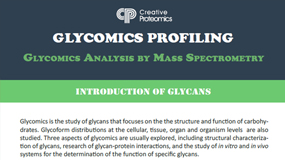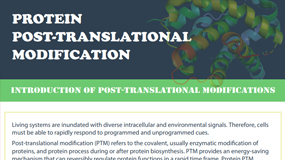What Is Peptidoglycan
Peptidoglycan (also referred to as murein), an essential and specific component of the bacterial cell envelope, forms a mesh-like layer outside the cytoplasmic membrane, is responsible for rigidity and shape of bacterial cells and protects them from osmotic disruption. Indeed, any inhibition of its biosynthesis (mutation, antibiotic) or its specific degradation (e.g. by lysozyme) during cell growth will result in cell lysis. Peptidoglycan also contributes to the maintenance of a defined cell shape and serves as a scaffold for anchoring other cell envelope components such as proteins and teichoic acids. It is intimately involved in the processes of cell growth and cell division. It is a polymer that occurs in cell walls of both Gram-positive and Gram-negative bacteria but has not been found in Archaea. In Gram-positive bacteria it represents about 30-70% of the cell wall aside from polysaccharides, teichoic or teichuronic acids. It is only a minor component in Gram-negative cell walls that mainly consist of lipopolysaccharides and lipoproteins. The investigation of peptidoglycan structure exerts a vital roles in understanding immune responses, the action of antibiotics and mechanisms of resistance, phage susceptibility and serological behavior, and on bacteria classification and identification.
The Composition and Structure of Peptidoglycan
Peptidoglycan features a multi-layered mesh-like macromolecular structure with disaccharide units. The disaccharide units, comprising N-acetylglucosamine and N-acetylmuramic acid, are interconnected and alternately linked, forming the peptidoglycan backbone that imparts the mesh-like structure. The tetrapeptide side chains, alternatively composed of L- and D-amino acids, are attached in sequence. In Gram-positive bacteria, the composition and sequence of amino acids in the tetrapeptide side chains are diverse. For instance, Staphylococcus aureus exhibits a tetrapeptide tail sequence of L-Ala → D-Glu → L-Lys → D-Ala, while Corynebacterium poinsettiae displays L-Ser → D-Glu → L-Orn → D-Ala. In Gram-negative bacteria, the tetrapeptide tails are comparatively similar, often forming short peptides that connect neighboring units, yielding a mesh-like arrangement. The mechanical strength of peptidoglycan molecules derives from this grid-like structure. The peptide bridge is formed through direct or indirect crosslinking between the 4th amino acid of one tetrapeptide tail and the 3rd amino acid of another. In direct crosslinking, the amino and carboxyl groups on the two tetrapeptide tails undergo condensation to form a peptide bond (-CO-NH-), yielding weaker continuity compared to indirect crosslinking. The short peptides in the peptide bridge exhibit diverse variations, and their connectivity and chemical composition vary across different bacteria, contributing to variations in cell wall thickness. Bacteria with direct crosslinking possess denser mesh-like structures compared to those with indirect crosslinking, resulting in smaller thickness.
In summary, peptidoglycan is a heteropolymer characterized by glycan strands crosslinked with peptides. The glycan backbone consists of alternating N-acetylglucosamine and N-acetylmuramic acid units linked by β-1,4-glycosidic bonds. The peptide subunits, containing alternating L- and D-amino acids, attach to the glycan strands via N-acetylmuramic acid lactyl groups. Crosslinking typically involves the carboxyl group of D-Ala at position 4 and the amino group of the diamino acid at position 3, either directly or through a short peptide bridge. As a three-dimensionally crosslinked structure, peptidoglycan is usually insoluble.
 Figure 1. Schematic representation of the peptidoglycan network structure
Figure 1. Schematic representation of the peptidoglycan network structure
Structural Analysis Methods of Peptidoglycan
The structural analysis of peptidoglycan involves breaking down its complex composition into its constituent parts in order to understand its molecular structure and composition. Peptidoglycan is composed of alternating glycan (sugar) chains and peptide (amino acid) chains, linked together in a cross-linked network. To gain insight into these components and their arrangements, various analytical techniques are employed.
Hydrolysis and Enzymatic Digestion
Hydrolysis refers to the process of breaking chemical bonds using water molecules. In the context of peptidoglycan analysis, hydrolysis is used to break down the peptide bonds and glycosidic bonds within the structure. This can yield amino acids, peptides, and sugars. Enzymatic digestion involves using specific enzymes to break down the glycan strands into smaller fragments called muropeptides.
| Analytical Technique | Description |
|---|---|
| Thin Layer Chromatography (TLC) | Separates compounds based on polarity. Analyzes amino acid composition of peptidoglycan fragments obtained from hydrolysis or enzymatic digestion. |
| Gas Chromatography (GC) | Separates and analyzes volatile compounds. Used for analyzing amino acid and peptide composition in peptidoglycan analysis. |
| Mass Spectrometry (MS) | Identifies and quantifies molecules based on mass-to-charge ratio. Provides detailed information about peptidoglycan composition and structure. |
| Two-Dimensional TLC (2D-TLC) | Involves two rounds of TLC using different solvent systems. Offers enhanced separation and information about peptidoglycan components. |
| Chiral Column Gas Chromatography | Specialized GC technique for analyzing enantiomers (mirror-image isomers) of amino acids. |
| Dinitrophenylation | Determines N-terminus of interpeptide bridges in peptidoglycan using dinitrophenylation method. |
Peptidoglycan Structure Analysis Services at Creative Proteomics
Our Peptidoglycan Structure Analysis Services at Creative Proteomics provides accurate and reliable structural analysis of peptidoglycans for in-depth insights into the composition and configuration of peptidoglycan, contributing to our understanding of bacterial biology and potential therapeutic targets.
Our range of services encompasses, but is not restricted to:
Comprehensive Structural Analysis: Our analyses encompass a meticulous examination of the glycan and peptide constituents within peptidoglycan. Leveraging sophisticated techniques, we unveil the intricate configuration of its structure.
Amino Acid Composition: Employing methodologies such as GC and MS, we discern and quantify the amino acid composition, affording valuable insights into the fundamental constituents of peptidoglycan.
Cross-Linking Analysis: Our suite of services incorporates cross-linking analysis, a pivotal tool for unraveling the interconnections between glycan and peptide chains, pivotal to the structural integrity.
Enantiomer Analysis: Through the utilization of chiral column GC, we meticulously analyze the enantiomeric variations within peptidoglycan's peptide chains, deepening our comprehension of its structural subtleties.
Mechanical Properties: Employing cutting-edge techniques, we delve into the mechanical robustness emanating from the lattice-like architecture of peptidoglycan.
Interpeptide Bridge Characterization: By means of dinitrophenylation, we ascertain the N-termini of interpeptide bridges, contributing to a holistic grasp of the structural framework.
Benefits of Peptidoglycan Structure Analysis Services
Expertise and Proficiency: Our team consists of seasoned specialists boasting substantial expertise in the realm of peptidoglycan structure analysis.
Leading-Edge Methodologies: Employing avant-garde analytical methodologies, we ensure meticulous and all-encompassing investigations.
Tailored Approaches: Our services are adaptable to align with the unique contours of your research requisites, yielding outcomes that are focused and pertinent.
Dependable Outcomes: Creative Proteomics steadfastly upholds a commitment to furnish outcomes of the utmost caliber—results that are both reproducible and trustworthy.
Functions of Peptidoglycan
Immunomodulatory Role of Peptidoglycan
Peptidoglycan holds the capacity to stimulate the immune system, triggering the release or expression of immune mediators, consequently augmenting immune responsiveness. Peptidoglycan from lactobacilli exhibits immunoregulatory properties, capable of activating macrophages and polyclonal B cells in vitro, even in mammals and invertebrates. In vivo, peptidoglycan directly interacts with target cells or induces cell cytokine release, leading to various symptoms of bacterial infection.
Anticancer Function of Peptidoglycan
The biological functions of peptidoglycan have garnered extensive attention, with both its immunomodulatory and anticancer functions being extensively explored by researchers. Sekine et al. demonstrated the anticancer effect of peptidoglycan using a mouse subcutaneous Meth-A fibrosarcoma transplantation model. According to studies by Macy et al., peptidoglycan from lactobacilli induces the production of TNF-α, which can bind to the Fas-Fas ligand system on target cells, inhibiting tumor cell growth and inducing programmed cell death.
Inflammatory Properties of Peptidoglycan
Peptidoglycan can secrete certain cytokines and substances that render bacteria inflammatory. The PG-PS of many bacteria, including both commensals and pathogens, can trigger inflammatory responses. Previous research has indicated that PG-PS-induced experimental animal diseases encompass a range of conditions such as mild cutaneous nodular lesions, murine myocarditis similar to rheumatic heart disease, synovitis of the knee joint, granulomatous hepatitis in Lewis rats, and choroiditis, collectively suggesting the potential of PG-PS to induce multisystem diseases.
Activation of Enzyme Systems
Peptidoglycan might activate intracellular enzyme systems through specific pathways, promoting the expression of certain proteins and consequently influencing cellular functions.
In summary, peptidoglycan exhibits a spectrum of complex biological functions, including immunomodulation, anticancer activity, inflammatory responses, and enzyme system activation. These diverse roles underscore its significance in bacterial physiology and interactions with the host environment. Ongoing research continues to illuminate the intricate mechanisms underlying these functions.




















